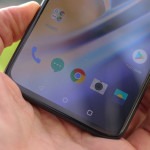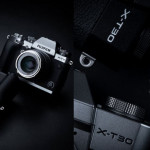
EARLY VERDICT
The Samsung Galaxy Fold ushers in an exciting new mobile form factor. It may have its negatives, which for some will rightly be a deal-breaker, but for those seeking the latest in cutting-edge technology the Fold should be top of your list.
FOR
- Supremely cool form factor
- Great display with HDR10+
- Six cameras (yes, SIX!)
AGAINST
- Noticeable crease in large screen
- Huge price
- No 5G or expandable storage
Update: After reported malfunctioning of the foldable displays, Samsung is officially delaying the Galaxy Fold’s April 26 launch while it gathers feedback, runs tests and fixes the display issues. The company didn’t give a new release date, only offering that they’d announce one “in the coming weeks.”
The Samsung Galaxy Fold is one of the most exciting smartphones of 2019, which the company kept out of reach with stage demonstrations, and behind thick glass at events.
Yet weeks before the Galaxy Fold is slated to go on sale, Samsung decided the handset was now ready for its close-up with the media – albeit for a brief span of time. At long last, we’ve gotten our hands on the first flagship foldable phone.
Our first impressions of the Samsung Galaxy Fold are positive. The folding mechanism feels secure, the large 7.3-inch display looks great, and the fact that you can fold it in half and stick it in your pocket (just about) is certainly cool.
It’s not without its more controversial points though – it’s big and heavy, and there’s a noticeable crease in the screen when the device is unfolded. However, rather more alarmingly a number of review units handed out to media have developed faults with the main display, and Samsung has promised to “thoroughly inspect” the troublesome handsets.
Read on to find out what we made of the Samsung Galaxy Fold…
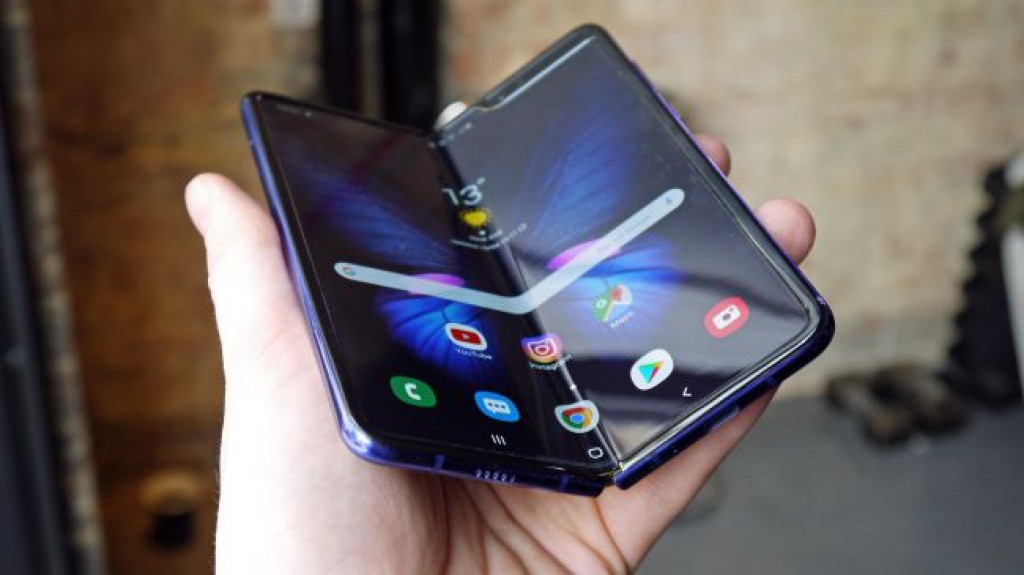
Samsung Galaxy Fold release date and price
The official Samsung Galaxy Fold release date is April 26 in the US, while in the UK and Europe pre-orders open on April 26, with the device available from May 3. However, after several reports suggesting delays in China and around the globe, Samsung officially confirmed it would push off the launch until later in order to fix issues causing malfunctioning displays. The company stated they would announce a release date “in the coming weeks.”
In the US, AT&T is taking pre-orders now, while T-Mobile will start selling the phone online and in stores on April 26. In the UK you’ll be able to buy the Galaxy Fold from the Samsung website and from EE.
The Samsung Galaxy Fold price is $1,980 / £1,800 (€2,000), which makes it one of the most expensive smartphones on the market, and pretty much matches the cost of the forthcoming foldable Huawei Mate X.
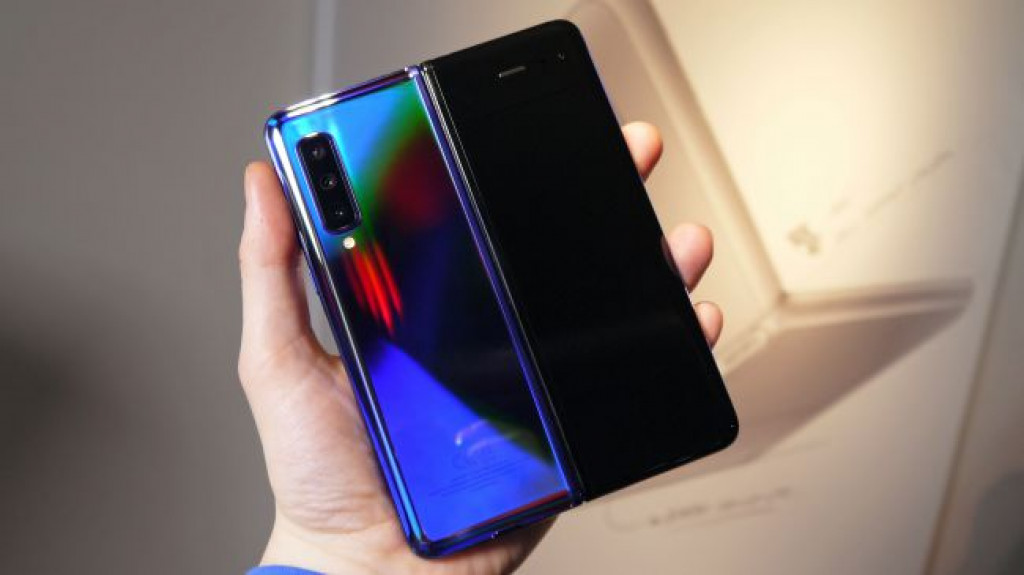
Design
Samsung believes the Galaxy Fold has the most intuitive form factor for a foldable phone, with the screen folding in on itself to provide protection, much like laptop.
The company certainly hasn’t taken the challenge of designing of its first foldable phone lightly. This is a phone that’s been 10 years in the making and has gone through over 1,000 different prototypes.
The book-like folding action does feel like a natural way to open the handset, and it’s certainly easier to get to grips with than the Huawei Mate X – Huawei has taken the opposite design approach to Samsung, with the screen on the outside of its device when it’s folded.
Open up the Galaxy Fold fully to reveal the 7.3-inch display and the 20-part, dual-axis hinge locks into place, preventing you from over-extending the display past 180 degrees.
Fold it back up and the phone snaps shut with a satisfying sound, giving you confidence that it won’t accidentally unfurl itself in your bag.
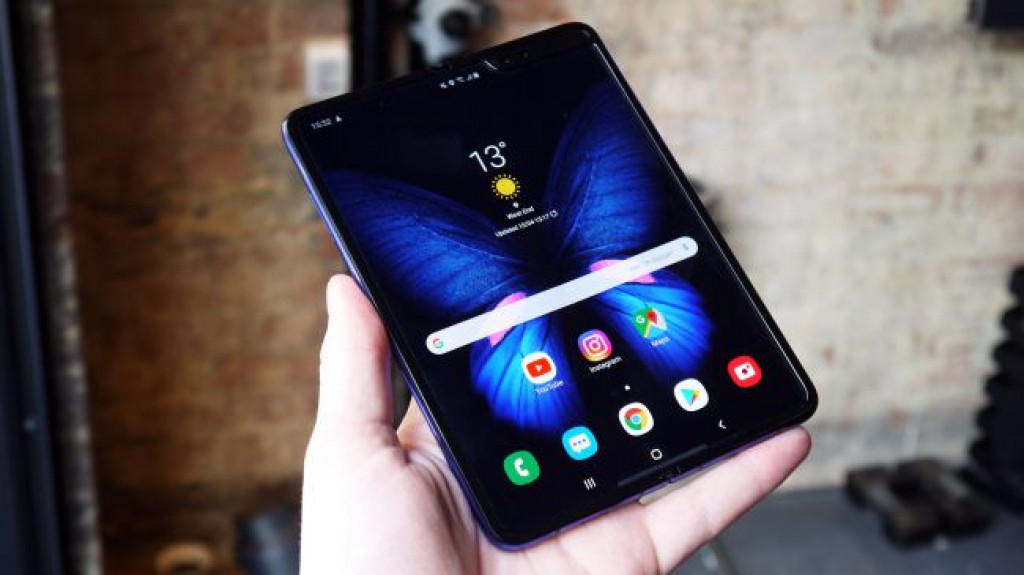
Samsung has spent a lot of time working on the dual-axis hinge, and it gives the device a tactile feel, with a smooth movement between its two states. It’s been designed to withstand more than 200,000 folds and unfolds, which works out at 100 opens and shuts a day for five years – so it should last.
It certainly feels sturdy, and capable of surviving repeated folding and unfolding, and a nice touch is the way the hinge disappears into the body of each half of the phone when it’s fully opened.
The fingerprint sensor is located on the right edge of the lower half of the device when it’s closed, falling nicely under thumb or finger, and so it remains in that position when the phone is unfolded. The sensor also acts as a Bixby launch button when pressed, jumping you straight into Samsung’s smart assistant.
Above the digit reader there are power/lock and volume keys, also in easy-to-reach positions, while on the base of the Fold you’ll find a USB-C port on one half of the bottom frame and a speaker on the other half. There is, however, no headphone jack.
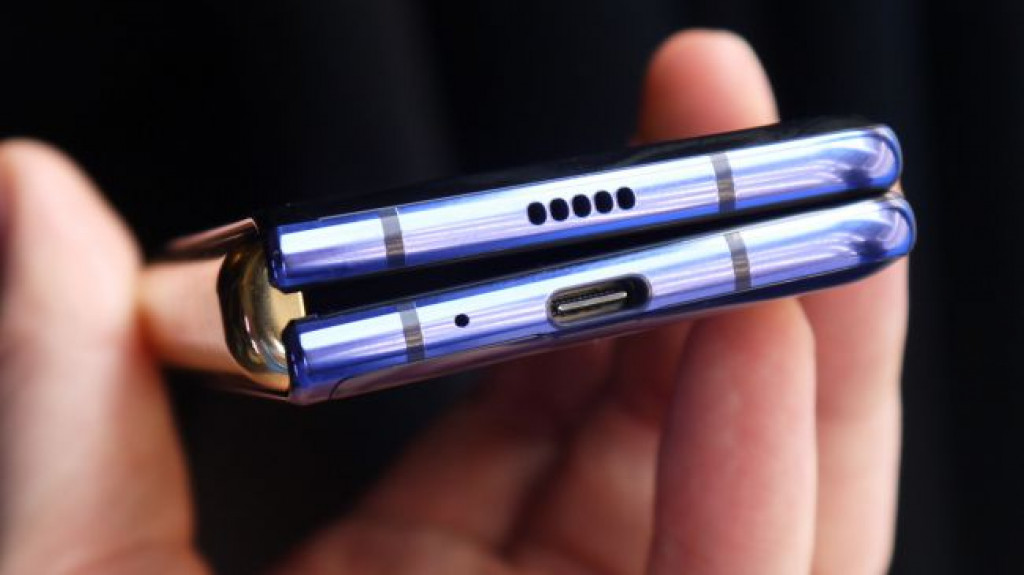
Samsung has spent a lot of time working on the dual-axis hinge, and it gives the device a tactile feel, with a smooth movement between its two states. It’s been designed to withstand more than 200,000 folds and unfolds, which works out at 100 opens and shuts a day for five years – so it should last.
It certainly feels sturdy, and capable of surviving repeated folding and unfolding, and a nice touch is the way the hinge disappears into the body of each half of the phone when it’s fully opened.
The fingerprint sensor is located on the right edge of the lower half of the device when it’s closed, falling nicely under thumb or finger, and so it remains in that position when the phone is unfolded. The sensor also acts as a Bixby launch button when pressed, jumping you straight into Samsung’s smart assistant.
Above the digit reader there are power/lock and volume keys, also in easy-to-reach positions, while on the base of the Fold you’ll find a USB-C port on one half of the bottom frame and a speaker on the other half. There is, however, no headphone jack.
As fun and futuristic as the Galaxy Fold design is, however, it’s also big, bulky and heavy. The Fold measures 62.9 x 160.9 x 17mm, making it double the thickness of most smartphones – that means it’s not so easy to slide into pockets, especially if you’re a fan of skinny jeans.
It tips the scales at 269g, making it one of the heaviest devices on the market. For comparison, the Galaxy S10 Plus is 175g, the iPhone XS Max is 208g, and the Huawei Mate 20 Pro comes in at 189g.
The Galaxy Fold will be available in Space Silver, Cosmos Black, Martian Green and Astro Blue, with the green and blue variants exclusive to Samsung’s website.
In the hand the Gorilla Glass 6-covered Galaxy Fold feels solid, but it doesn’t quite have the same premium appeal as its S10 siblings, which present a classier finish in the palm.
Another thing to note is that the Galaxy Fold is a huge fingerprint magnet – we were constantly wiping the handset down during our hands-on time, and the super-reflective glass body shows up fingerprints clearly.
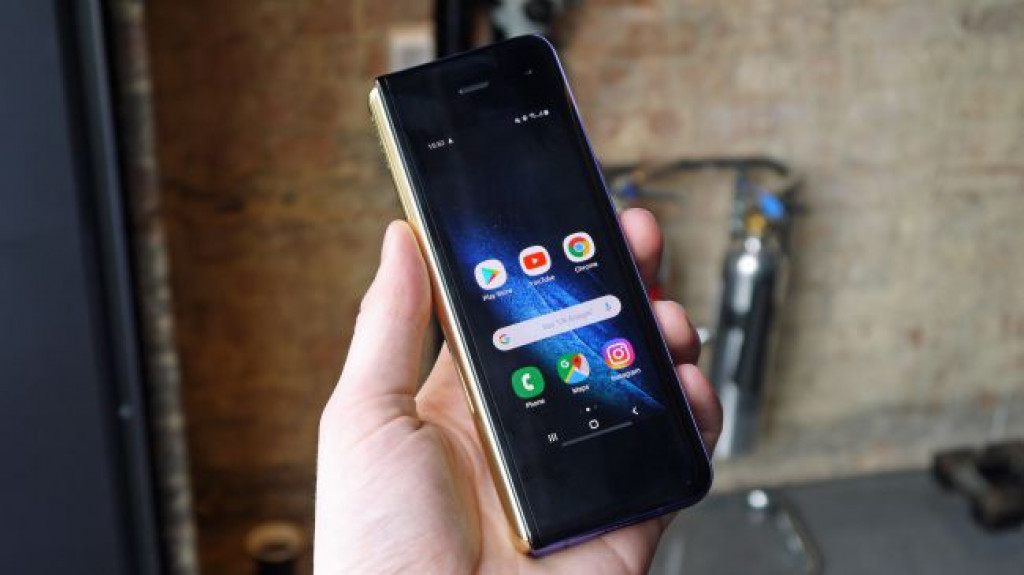
Display
The Samsung Galaxy Fold has two screens, with the 4.6-inch HD+ Super AMOLED display on the front (when the device is closed in ‘phone mode’) feeling a little small by today’s standards, when most phones have screens which are at least five inches in size.
It’s made to feel smaller thanks to the sizable bezels above and below, reminiscent of phones from around 10 years ago. It’s a trade-off that has to be made, as the tech has to fit somewhere, and the benefit of its diminutive size is that it can be easily used one-handed.
In terms of aesthetics, though, it’s far from pleasing to the eye. In a world where bezels are disappearing almost completely, the look here is a real blast from the past – and when you consider the asking price for the Samsung Galaxy Fold, some may argue that its appearance, at least in ‘phone mode’, doesn’t quite match its premium price tag.
The small display is bright and clear though, with Samsung’s Super AMOLED panel providing plenty of color. You can easily navigate Android, and it’s useful for checking notifications, reading messages and controlling music playback.
The larger tablet display, which comes into play when the phone is opened, features an advanced composite polymer layer that’s stuck to the body with a foldable adhesive, allowing the display to bend. It’s also the thinnest display Samsung has ever made.

Display
The Samsung Galaxy Fold has two screens, with the 4.6-inch HD+ Super AMOLED display on the front (when the device is closed in ‘phone mode’) feeling a little small by today’s standards, when most phones have screens which are at least five inches in size.
It’s made to feel smaller thanks to the sizable bezels above and below, reminiscent of phones from around 10 years ago. It’s a trade-off that has to be made, as the tech has to fit somewhere, and the benefit of its diminutive size is that it can be easily used one-handed.
In terms of aesthetics, though, it’s far from pleasing to the eye. In a world where bezels are disappearing almost completely, the look here is a real blast from the past – and when you consider the asking price for the Samsung Galaxy Fold, some may argue that its appearance, at least in ‘phone mode’, doesn’t quite match its premium price tag.
The small display is bright and clear though, with Samsung’s Super AMOLED panel providing plenty of color. You can easily navigate Android, and it’s useful for checking notifications, reading messages and controlling music playback.
The larger tablet display, which comes into play when the phone is opened, features an advanced composite polymer layer that’s stuck to the body with a foldable adhesive, allowing the display to bend. It’s also the thinnest display Samsung has ever made.
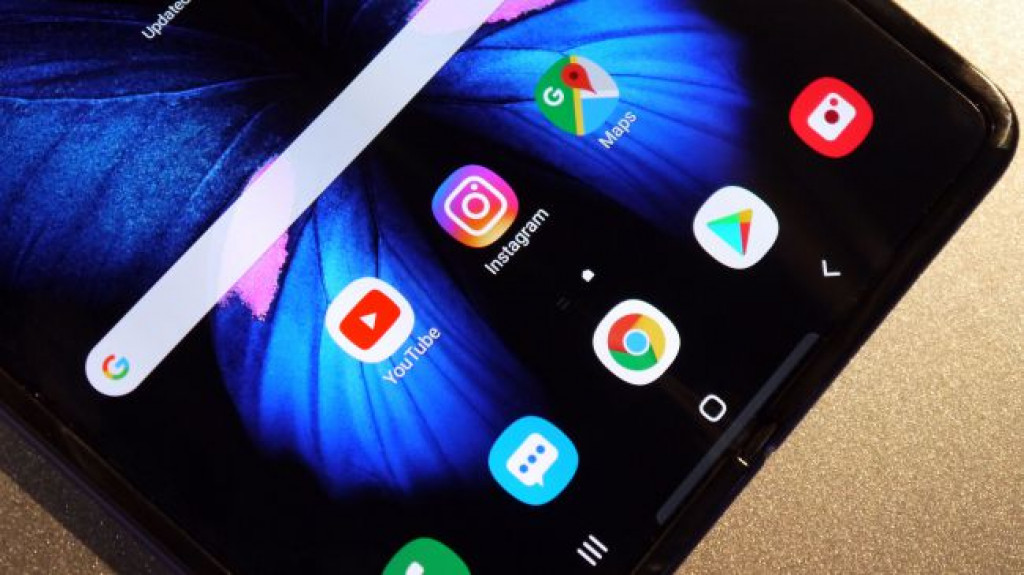
Interface and performance
There are various ways you can use the Samsung Galaxy Fold. When closed, the ‘phone mode’ provides one-handed operation for tasks such as calls and music playback.
The 4.6-inch display operates like that of a regular smartphone, so apps and games work as you’d expect, although with a bigger screen just a quick unfold away, working on the smaller screen can feel cramped.
Open the device up into ‘tablet mode’, and the larger screen makes social media, messaging, web browsing, gaming and photo/video editing much easier.
Each time you transition from one screen to the other, compatible apps will follow your usage patterns for a seamless experience. For example, if you launch Google Maps in ‘phone mode’, and then open the Fold up, Google Maps will automatically be displayed on the big screen.
Every app that comes pre-installed on the Galaxy Fold (including Google’s suite of apps, WhatsApp and Microsoft Office) supports continuity between displays, and it’ll be up to other developers to make their applications compatible.
Samsung says it’s easy to add the necessary functionality, as it doesn’t require developers to redesign existing apps – they just need to add extra features – but we’ll have to wait and see how widely it’s adopted.
It’s also unclear how many apps will support the 4:3 aspect ratio of the Galaxy Fold’s tablet mode display, as it’s much squarer than the screens currently found on smartphones – there may be a bit of a wait while core apps build in support for this aspect ratio.
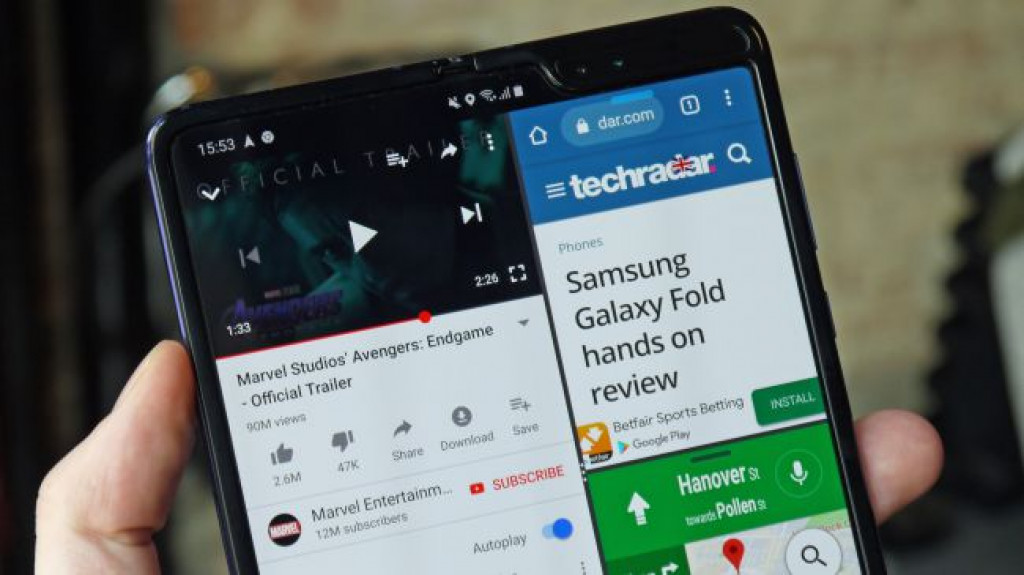
You can also use two or three different apps side-by-side on the large display in multi-active window mode. Open up an app on the big screen, then slide your finger in from the middle of the right side to open up a panel of compatible multi-active window apps. Tap one and it’ll gobble up half of the display, alongside the app that’s already open.
Perform the same action to bring up the app menu again, and tap a third choice, and this app will then take up a quarter of the display, below the second app which is also reduced in size to 25%.
You can then swap the positions of the apps by dragging and dropping them, and you can adjust the width of the apps by dragging the central division line from side to side.
It all worked well during our time with the Galaxy Fold, with apps opening and re-sizing promptly, and we can see the benefits that being able to have multiple apps open on a large display will bring.
Load up a game – Asphalt 8 in our case – on the big screen and the Galaxy Fold will automatically rotate the app 90 degrees, forcing you to turn the device. There’s a clever reason for this though, as it provides better orientation for the stereo speakers for an improved audio experience.
The Samsung Galaxy Fold has been optimized with the Unity Game Engine, which means games which run on that platform will perform superbly here.
There’s more than enough power under the hood, with the Galaxy Fold packing a 7nm octa-core processor and 12GB of RAM. It means Android 9 – coated in Samsung’s One UI – runs smoothly under finger, with apps opening swiftly.
You also get 512GB of storage inside the Fold, providing plenty of space for apps, games, movies, music, photos and more, and for most that will be more than you’ll ever use – for serious power users, though, it’s worth noting that the Galaxy Fold doesn’t offer any expandable storage, so you’re stuck with that 512GB, unless you opt to send your data to the cloud.
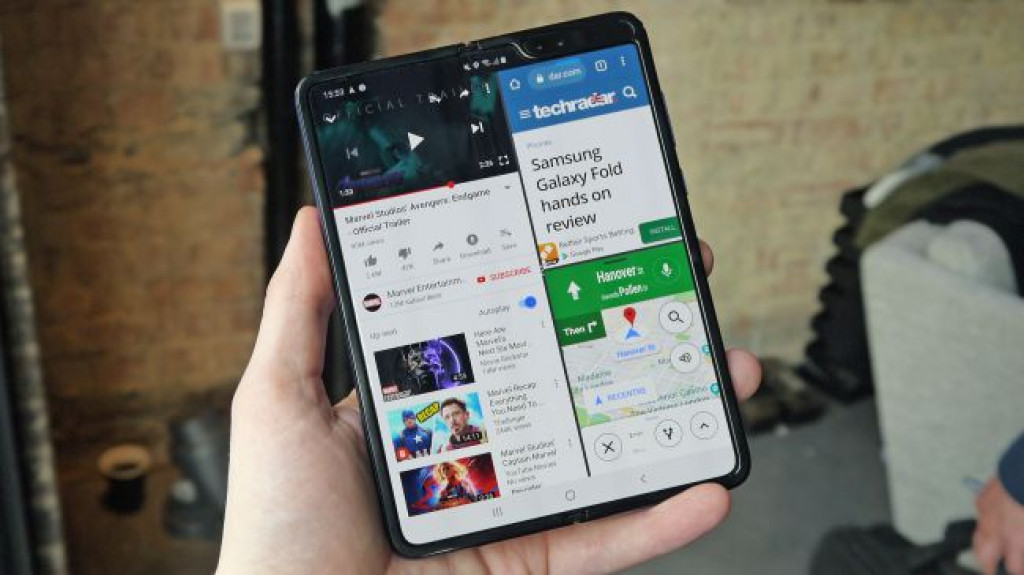
Cameras and battery
The Samsung Galaxy Fold comes with six cameras – yes, six. The main trio are found on the rear of the device, with a 12MP main sensor (f/1.5-f/2.4, OIS) joined by a 12MP telephoto lens (f/2.4, OIS) and a 16MP ultra-wide angle lens (f/2.2).
This is exactly the same setup as you’ll find on the Samsung Galaxy S10 and Galaxy S10 Plus, so performance should be excellent, although we weren’t able to test them out on the Galaxy Fold as it wasn’t running final software.
You get one, 10MP (f/2.2) camera on the front of the Galaxy Fold, above the 4.6-inch display, for the odd gratuitous selfie or hastily arranged video conference, while opening up the device reveals two cameras in a notch which eats into the top-right of the display.
Within this notch a 10MP camera (with the same specs as the selfie camera) is joined by an 8MP (f/1.9) depth-sensing camera which provides the information for Samsung’s background blur Live Focus mode.
The benefits of having a large, 4:3 aspect ratio display when it comes to photography are clear. First up, you get a sizable live preview, giving you a clear indication of what your photo will look like before you hit the shutter button.
Second, the 4:3 aspect ratio matches the aspect ratio of the cameras, and thus your final images, which means that what you see on-screen is exactly what will show up in your camera roll, with the whole screen used and no black bars filling in wasted space.

Turning to the battery, and the Samsung Galaxy Fold breaks with tradition again as it packs two power packs – one in each half.
The two batteries combine to provide a total capacity of 4,380mAh, which Samsung told TechRadar should provide “all-day power”, although that will be heavily dependent on how you use the handset.
If you spend most of your time using the 7.3-inch tablet display we expect the battery will drain much faster – but you’ll have to wait for our in-depth review to find out just how it fares.
The Galaxy Fold supports wireless charging, and it packs the same Wireless PowerShare feature as the Galaxy S10 and S10 Plus, allowing you to charge other wireless-charging compatible devices on the rear.
It even has a small magnet by the charging coil to keep devices – such as the Galaxy Buds – in place, which should hopefully avoid them slipping off easily.
In the box
The Samsung Galaxy Fold price is lofty, but it does at least come packaged as a premium handset should. The box is constructed with eco-friendly material, and is emblazoned with Samsung’s embossed Fold graphics.
Open it up and you get the phone, charging block and cable, but there’s more: Samsung is also bundling in a pair of Galaxy Buds wireless earphones (MSRP: $149 / £139 / AU$249), along with a slim, lightweight, yet strong case for the Galaxy Fold for a bit of added protection.
Every Galaxy Fold purchaser will also get a year’s free insurance via Samsung Care Plus, which covers you against the likes of accidental and water damage. And finally, there’s a year’s YouTube Premium subscription bundled in as well.
Early verdict
The Samsung Galaxy Fold is an exciting entrant into the smartphone market, breaking the static rectangle mold that we’ve become accustomed too, and bringing us two displays, two batteries and six cameras.
Sure it’s expensive – but the first generation of any new technology is – while people will point to its size, weight, screen crease and bezels around the smaller display as negative points; and for some, one or more of those may be deal-breakers.
However, the Galaxy Fold is more than a standalone handset. It, along with the Huawei Mate X, and others to come, ushers in an exciting new mobile form factor which will only be refined, improved and made more affordable over the next 12-18 months – and you’ll have this phone to thank for that.
If you want to be ahead of the curve – sorry fold – the Samsung Galaxy Fold can get you there, right now… and that in itself is impressive.
Source: techradar.com





































